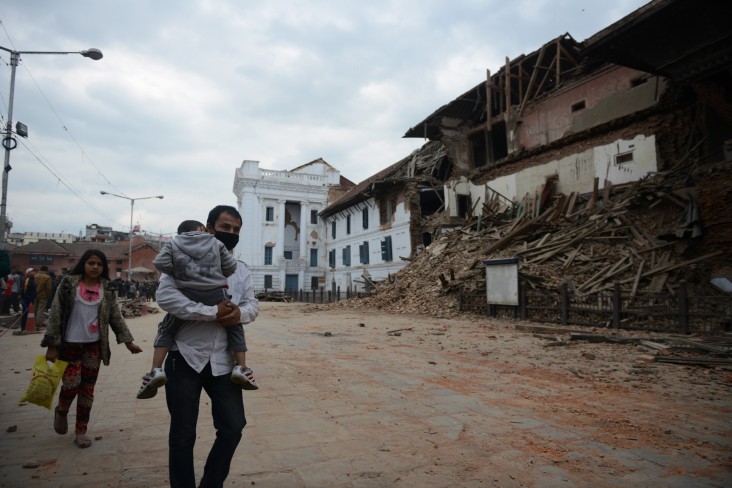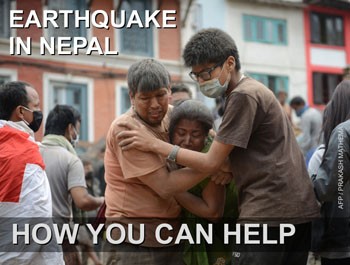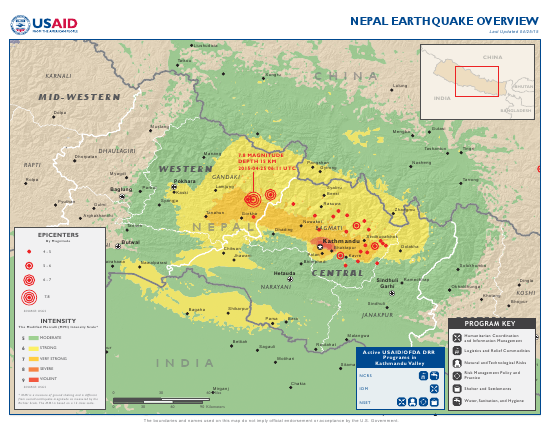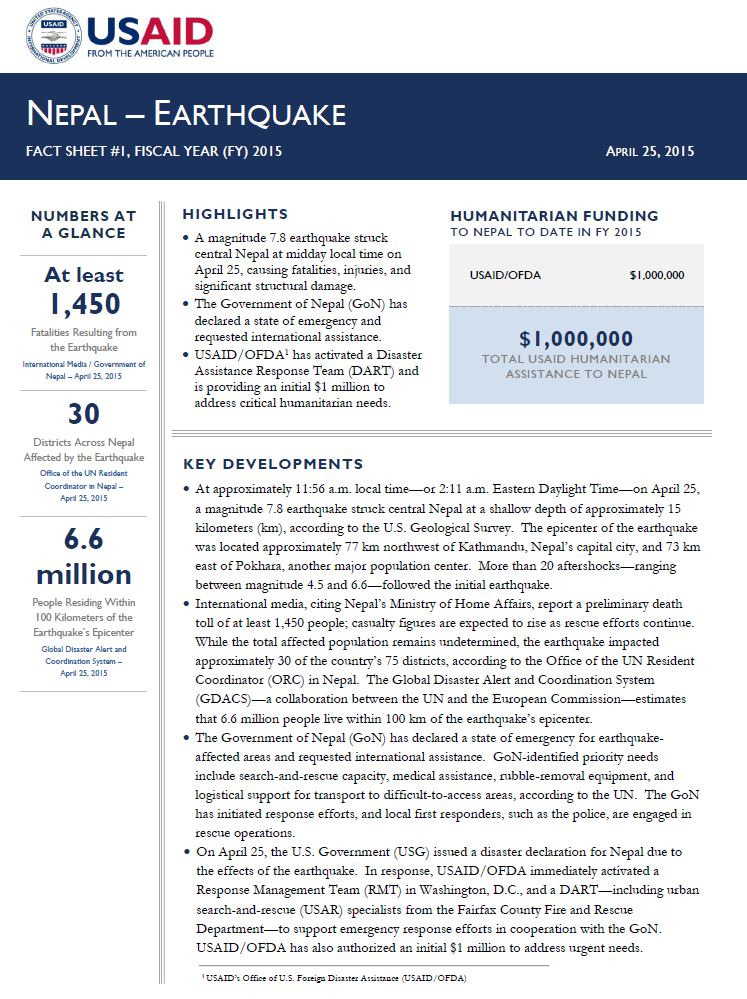April 25, 2015
Highlights
A magnitude 7.8 earthquake struck central Nepal at midday local time on April 25, causing fatalities, injuries, and significant structural damage.
The Government of Nepal (GoN) has declared a state of emergency and requested international assistance.
USAID/OFDA has activated a Disaster Assistance Response Team (DART) and is providing an initial $1 million to address critical humanitarian needs.
Key Developments
Nepal Earthquake Map - April 25, 2015 ![]() (pdf - 1 MB)
(pdf - 1 MB)
Numbers At A Glance
At least 1,450
30
6.6 million
Humanitarian Funding:
To Nepal To Date In FY2015:
| USAID/OFDA | $1,000,000 |
| TOTAL | $1,000,000 |
Nepal Earthquake Fact Sheet #1 - April 25, 2015 ![]() (pdf - 195k)
(pdf - 195k)
At approximately 11:56 a.m. local time—or 2:11 a.m. Eastern Daylight Time—on April 25, a magnitude 7.8 earthquake struck central Nepal at a shallow depth of approximately 15 kilometers (km), according to the U.S. Geological Survey. The epicenter of the earthquake was located approximately 77 km northwest of Kathmandu, Nepal’s capital city, and 73 km east of Pokhara, another major population center. More than 20 aftershocks—ranging between magnitude 4.5 and 6.6—followed the initial earthquake.
International media, citing Nepal’s Ministry of Home Affairs, report a preliminary death toll of at least 1,450 people; casualty figures are expected to rise as rescue efforts continue. While the total affected population remains undetermined, the earthquake impacted approximately 30 of the country’s 75 districts, according to the Office of the UN Resident Coordinator (ORC) in Nepal. The Global Disaster Alert and Coordination System (GDACS)—a collaboration between the UN and the European Commission—estimates that 6.6 million people live within 100 km of the earthquake’s epicenter.
The Government of Nepal (GoN) has declared a state of emergency for earthquake-affected areas and requested international assistance. GoN-identified priority needs include search-and-rescue capacity, medical assistance, rubble-removal equipment, and logistical support for transport to difficult-to-access areas, according to the UN. The GoN has initiated response efforts, and local first responders, such as the police, are engaged in rescue operations.
On April 25, the U.S. Government (USG) issued a disaster declaration for Nepal due to the effects of the earthquake. In response, USAID/OFDA immediately activated a Response Management Team (RMT) in Washington, D.C., and a DART—including urban search-and-rescue (USAR) specialists from the Fairfax County Fire and Rescue Department—to support emergency response efforts in cooperation with the GoN. USAID/OFDA has also authorized an initial $1 million to address urgent needs.
CURRENT SITUATION – NEPAL
Preliminary information suggests that the earthquake most severely affected Gorkha and Lamjung districts in Western Development Region’s Gandaki Zone, according to the ORC in Nepal.
In Kathmandu and surrounding areas, the earthquake has resulted in widespread damage and destruction of buildings, many of which have collapsed, according to international media. However, the ORC in Nepal notes that overall damage is less than expected.
The earthquake also damaged roads and other public infrastructure. USG staff in Kathmandu report that electrical and telecommunications networks are intermittently operational, although landlines appear to function.
According to the ORC, the airports in Kathmandu and Pokhara remain open, with some commercial flight activity reportedly resumed.
CURRENT SITUATION – REGIONWIDE
In India, communities in Uttar Pradesh, Bihar, and Sikkim states experienced strong shaking, with aftershocks reaching the city of Delhi, according to local reports. International media report at least 36 deaths related to the earthquake.
In Bangladesh, the earthquake resulted in at least four deaths, and more than 100 people sustained injuries, according to local and international reports. Several buildings, including multiple schools, were damaged.
On Mt. Everest, the earthquake triggered an avalanche, resulting in at least 18 deaths, according to international media.
In China, international media report at least 12 fatalities related to the earthquake.
NATIONAL AND INTERNATIONAL RESPONSE

The GoN activated its national emergency operation center and convened a meeting of its Central Natural Disaster Relief Committee (CNDRC) on April 25, according to the ORC in Nepal.
The ORC reports that the GoN is deploying small teams of medical staff to Kathmandu hospitals to supplement existing capacity; additional medical teams from Chitwan and Pokhara are traveling to hard-hit Gorkha and Lamjung districts to provide assistance. Preliminary information indicates that hospitals throughout Kathmandu Valley have become overcrowded and medical supplies are nearing depletion.
Per the International Federation of Red Cross and Red Crescent Societies (IFRC), the Nepal Red Cross Society (NRCS) is assisting in search-and-rescue efforts and providing first-aid to injured individuals. NRCS also plans to distribute limited stocks of emergency relief items available in country, and IFRC is mobilizing additional resources from hubs in New Delhi, India; Kuala Lumpur, Malaysia; and Bangkok, Thailand. In addition, IFRC plans to release funds from its disaster response emergency fund to support the initial emergency response in Nepal.
The Government of India reports mobilizing 10 National Disaster Response Force (NDRF) teams to assist with relief efforts in Nepal. An additional five NDRF teams will deploy to earthquake-affected areas within India.
The Government of the People’s Republic of China (GoPRC) reports that its 68-member search-and-rescue team is expected to arrive in Nepal on April 26.
The UN Humanitarian Country Team (UNCT) in Nepal held a meeting on the evening of April 25 local time. UNCT members are consolidating information on capacity and supplies for April 26.
According to Médecins Sans Frontières (MSF), four teams of medical and non-medical MSF staff are scheduled to reach Nepal on April 26 to assist earthquake-affected populations. MSF also plans to send 3,000 kits of emergency relief items.
The UN Office for the Coordination of Humanitarian Affairs (OCHA) plans to dispatch a team from Bangkok to Nepal on April 26. A UN Disaster Assessment and Coordination (UNDAC) team may also deploy if needed.
USG RESPONSE
In response to GoN requests for assistance, USAID/OFDA is deploying a DART to Nepal; the team comprises USAID/OFDA humanitarian specialists and 54 USAR personnel from the Fairfax County Fire and Rescue Department. USAID/OFDA has also allocated an initial $1 million for relief organizations in Nepal to address urgent humanitarian needs. In addition, a Washington, D.C.-based RMT is activated and coordinating the USG response to the Nepal earthquake.
For nearly two decades, USAID/OFDA has supported disaster risk reduction (DRR) efforts in Nepal, including throughout Kathmandu Valley. USAID/OFDA funding has enabled the International Organization for Migration (IOM) to identify, prepare, and preserve more than 80 open spaces in Kathmandu Valley to ensure the sites are available for humanitarian purposes—such as distribution centers or warehouses—in the event of large-scale disasters. USAID/OFDA has also supported NRCS to pre-position critical emergency relief supplies in order to address the immediate needs of affected communities following a disaster.
Through the Kathmandu-based National Society for Earthquake Technology (NSET), USAID/OFDA supported strengthening Nepal’s earthquake response capacity by institutionalizing DRR at the local and national levels in collaboration with the GoN, non-governmental organizations, schools, and local communities. With USAID/OFDA support, NSET is also promoting public-private partnerships for earthquake risk management and enhancing the capacity of municipal governments to develop and administer building code permits and control systems to better protect against seismic activity.
PUBLIC DONATION INFORMATION
The most effective way people can assist relief efforts is by making cash contributions to humanitarian organizations that are conducting relief operations. A list of humanitarian organizations that are accepting cash donations for disaster responses around the world can be found at www.interaction.org.
USAID encourages cash donations because they allow aid professionals to procure the exact items needed (often in the affected region); reduce the burden on scarce resources (such as transportation routes, staff time, and warehouse space); can be transferred very quickly and without transportation costs; support the economy of the disaster-stricken region; and ensure culturally, dietary, and environmentally appropriate assistance.
More information can be found at:
- The Center for International Disaster Information: www.cidi.org or +1.202.821.1999.
-
Information on relief activities of the humanitarian community can be found at www.reliefweb.int.










Comment
Make a general inquiry or suggest an improvement.